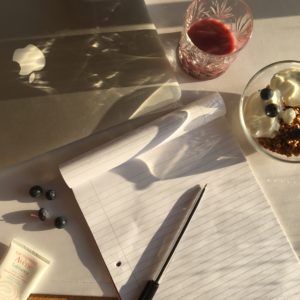Tips from Bryan who achieved H1s with 99% in Maths and 100% in each of Physics and Chemistry this year. He offers some tough love in this one, but I cannot quite disagree with him either! Enjoy the read – Martina
Introduction
For me, studying these subjects has always come down to three main principles: understanding , memorising, and reinforcing.
Understanding comes mainly in the form of your textbook and the occasional Youtube video. Of course, you can’t memorise the whole textbook! Writing out your own notes is a waste of time in most cases. You don’t gain any learning value from copying sentences in a textbook to a sheet of paper, you just feel like you’ve accomplished something when in fact there was no real engagement taking place.
It’s better to memorise definitions and facts from notes already written – that way LOTS of time is saved.
Next, once you’ve understood and memorised the information, you must reinforce it. This is done by doing as many exam questions as you can. Finally, exam technique. This must be perfected and it can save you a grade. Many times students are at the borderline of a H1, and not messing up a calculation/remembering to get the correct unit can save you.
Step 1: Understanding
Every time you’ve finished a chapter in class, go over it and think through the material deeply. If something is not logical to you, STOP! Time limits aren’t important here, which is why I believe that setting aside a certain time frame to study isn’t useful when trying to understand a difficult topic.
You can never know how long it is going to take you to understand something. To save yourself the frustration, remember this point: every time you commit to the struggle to understand, you will make recall (step 3) incredibly easy.
If the material still isn’t making sense, either ask your teacher or google it. I know that some teachers will just spit the textbook answer back at you, and at that point you should not ask them again for fear of annoying them and instead ask on a forum such as The Physics forum or Stack Exchange, which are helpful resources that I’ve used in the past.
Please note that skipping this step will not do you any justice. I’ve seen many friends go down the path of mindlessly spamming exam papers, not having a clue how to answer it, checking the marking scheme, writing it down neatly on a piece of paper, then never looking at the paper again. NO learning is being done here.
Be careful of going down rabbit holes – often your question will have a simple answer but you have a misconception about the topic. In this scenario you should skip it and come back to it in the future. Accepting that you can’t always understand everything straight away is an important perspective to have in life
Step 2: Memorising
There is only one way to fully internalise information, in my experience, which is active recall.
In physics and chemistry, there are many definitions. Marking schemes vary quite a bit, so I would recommend learning the definitions word perfect from your textbook/notes rather than learning them from the marking schemes.
Additionally, note that it can be a good idea to check for common definitions in past exam papers. However, please keep in mind that the SEC can still examine definitions that have never been asked before if it’s on the syllabus!
If you’ve completed Step 1, Understanding, you will have understood all the definitions. Generally, there is no need to go through Step 1 more than once unless you’ve forgotten the material.
Definitions in maths are quite scarce, with the bulk of them being in Statistics – I would recommend to have a brief read over them, but don’t go memorising them word perfect. Memorising proofs should be simple and near effortless once you have understood them and apply the following steps.
To memorise definitions/proofs, I advise you to get out a pen and a refill pad. Read the definition from your notes, then without looking at the notes, write out the definition/proof on the refill pad. There is no need to keep these pages.
Another method if you’re feeling a little tired is to recite the definition/proof in your head. However, you must be honest with yourself here – there is no cheating when you write things down!
Test yourself frequently. You should test yourself based on how well you did the last time when you tested yourself. If you can recite the definition/proof perfectly, great! No learning is done, but you have reinforced the material.
If you can’t recite the definition/proof, then spend some time on it. At least learning is being done. I can’t emphasise this enough – don’t be mad at yourself for forgetting things. It’s better to fix the gaps in your knowledge now, before it’s too late.
In order to solve problems with calculations, there is a form of memorisation needed here, which many people don’t prioritise enough and favour understanding.
Whether you are doing long division or a chemical equilibrium question, what is the point of being able to understand every step when your teacher does it, but not being able to reproduce it? It may come naturally some of the time, but some types of questions inevitably catch us off guard.
To memorise steps in those sort of questions, cover the solution with a blank sheet of paper and try the problem yourself.
Of course, occasionally there will be a type of question in the exam which you have never seen before (especially in maths), which is why Step 3, Reenforcing, is so important, and you should only attempt it after being getting comfortable with understanding and memorising a specific topic.
Step 3: Reinforcing
Students who get high grades often say it is because they did lots of exam papers. There is an important nuance here: doing lots of exam papers is all but worthless without understanding and memorising.
Take this scenario: Someone does exam papers without much knowledge, what do they end up doing? Look at question. Open marking scheme. Write down answer in marking scheme. Never look at it again. This will make you feel confident in yourself and you will feel like you are studying. On the contrary, NO learning is being accomplished here and is a waste of time.
Sure, you can memorise the marking schemes, but you will often be caught off guard, especially now as the SEC has started to change the questions in these subjects to understanding rather than memorising (for example, see 2023 Maths paper 1).
Additionally, memorising the marking scheme without covering the material itself makes recall incredibly difficult. Just because you can get 100% in the 2019 maths paper 2 having memorised the marking scheme doesn’t mean you will get even close to a H3 in a different paper without having seen the marking scheme beforehand.
Reinforcing the material by exam papers is self-explanatory, just do an exam question, check the marking scheme AFTER you’ve finished, correct it etc. If you fail to get the correct answer, check your notes again and repeat Step 2 (memorising) or Step 1 (understanding) as necessary.
Remember, you are not becoming worse at the subject by doing this. Rather, you are actually going to learn something instead of fooling yourself! I cannot stress this point enough.
If you can’t do a calculation in an exam paper, most people will look at the marking scheme. Terrible idea. Think through the question again, then look at your book. Take a break then come back to it. Only then will you look at the marking scheme. (When you are checking your answer, you will quickly glance at the solution, if it’s right, great! If it’s not, close the marking scheme and try again.)
If you are unable to follow the solution then I suggest asking online/your teacher. It’s easy to be frustrated when we can’t solve a problem. The good news is that feeling frustrated is acceptable! It’s a way to cope with something our brain can’t understand… yet! It all comes with enough practice and time spent on the three steps.
Additional thoughts:
Graphs
● Get a GOOD rubber
● Use a transparent ruler
● If you are plotting e.g. 1/volume, the unit is 1/metres^3, not metres^3
● Line of best fit can have 1 extra dot on either side, e.g. 4 on top, 2 on line, 3 on bottom
● Calibrate axis in 10’s – this will make it super easy to plot points – if the graph seems too small, you can turn the graph paper ninety degrees
● Always have the independent variable on the x-axis and dependent variable on the y-axis
Exam
● When picking questions, give a tick next to every subquestion you know you can answer and a cross next to every subquestion you don’t know the answer to. Sum these up and do your best questions. (If subquestion doesn’t have a mark number beside it, guess. Chances are you’ll be right.)
● Note weird units – found on page 45 of formulae and tables
● Don’t take the exam personally – it’s a job, nothing more
Experiments
● When asked to describe the procedure, give the full procedure (or as much as you can remember). Marking schemes change every year, so learn the procedure from your notes as opposed to marking schemes from a particular year.
● Draw diagrams in pencil, and use a ruler if necessary. Marks can be lost for wonky lines!
● It is easier if you memorise some often seen final figures e.g., Heat of neutralisation of HCl and NaOH = -57.12 (don’t forget minus sign!), specific heat capacity of water = 4200 etc. Also be aware that the question could try to trick you! E.g. it could be the specific heat capacity of oil!
● Some calculators have a built in “table” function – use this to save you time
How to make yourself study (in my experience)
When you first begin studying, you might have a lot of motivation. If you don’t, that’s okay too. You should be aware that it’s very rare for this motivation to last throughout the year.
Therefore, you need to turn to discipline rather than motivation when you can’t be bothered studying. There is no big secret to discipline. Just study even when you don’t want to. You’ll adapt and get used to it eventually.
Don’t set unattainable targets, this will lead to depression. How to avoid procrastination? Just do it. You set good habits for yourself by pushing through a bit at the start. The start is always the hardest. After a month or so habits will become more natural.
If you have a desire to check your phone, don’t do it. This is testing your willpower. There will always be things we have to do that we don’t want to do. You might get grumpy – try not to allow this to affect your life outside of study.
I would also advise to replace some of the countless hours you may spend on social with exercise – start with very easy exercise that takes little effort, and build up from there.
Never kill yourself with exercise – sometimes it’s the process, not necessarily the destination that we’re after. Better to start small and have your whole life to improve on it than push yourself too hard and end up quitting. Small steps means you can continue to improve! Unfortunately, we don’t have this luxury with the Leaving Cert!
As I mentioned earlier, understanding can eat up a lot of time, which is why you need to implement Step 1 (Understanding) and Step 2 (Memorising) as soon as possible after you’ve finished the chapter in class.
When you start studying, you shouldn’t really need to take a break for the first 45-60 minutes. After that you can take more frequent breaks (every 30 minutes) if needed.
Quiet is essential, and distractions will be your number one enemy. Isolate yourself from the world when doing these steps. With Step 3, it’s just reinforcing, so you can listen to music/study in a noisy environment provided recall is easy. If recall is hard, or you can’t solve a calculation, then this indicates that you need to focus again.

Another take on STEM subjects here

